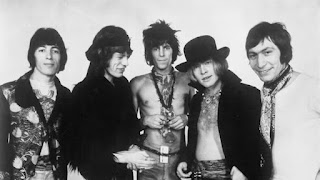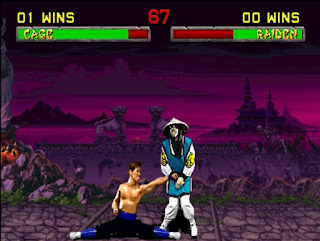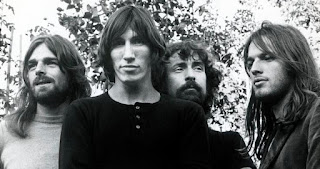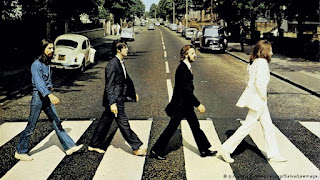My Life As an Air-Guitarist - Chapter 4: #1 "Sympathy for the Devil" The Rolling Stones
Need to get caught up on the Air-Guitar saga? Catch up here.
#1"Sympathy For the Devil" - The Rolling Stones
In the early years —between the ages of 5 and about 14— most of my air-guitaring revolved around rhythm guitar, strumming hard chords, and the occasional leg kick. 70s rock reigned in our house, so power chords from bands like Boston and Aerosmith were a heavy influence on not only my musical taste but also on my visual interpretations of songs like "More Than a Feeling" and "Back in the Saddle".
But "Sympathy for the Devil" was a real turning point in my playing and one of the first songs where I decided to start taking air-guitaring seriously. Much of my current technique was derived from this one guitar solo which I mastered by watching James Hubble do his best Keith Richards impersonations when I was in Jr. High. James was in high school and a friend of my older sister, Molly. He was an avid Stones fan, a Keith Richards fanatic, and a great air-guitarist. The clarity of the notes in this solo makes it a fantastic tune to practice your air guitar chops and it is also the first song I brought the thumb-to-finger method into. Any student of Hubble likely learns this method and likely learned it for "Sympathy for the Devil."
Here's James doing a classic Keith routine in our Norwell family room as I watched intently, capturing moves on film to study later.
As close as I hold "Sympathy" to my heart as one of my first perfected air-guitar solos, it does take a few minutes to get there.
But that's fine because the intro offers plenty of air-opportunities. When listening, it's only natural to start out following along with the congas, maybe trade-off with a few shakes of what sound like maracas but is actually the shekere played by Bill Wyman, and then, of course, pick up the bass, played by the versatile Keith Richards. This seems like a good time to let you know that "Sympathy for the Devil" also ranks as one of my top air-bass songs. If you listen to "Sympathy" and don't get the urge to play air-bass, you should go back and listen to it again. And if at that point, you still don't have the urge to play air-bass, you should look in the mirror and ask yourself, "what's wrong with me?"
The shekere is a fun one to riff on too, but I'm not pretending I know how to play one. I pretend to know how to play many things, but the shekere is not one of them. So, for the purpose of "Sympathy," I am all maracas. But, for me, this is not the greatest maraca (ahem, shekere) performance in a Rolling Stones song. That is reserved for Rocky Dijon's maraca performance on "Jumpin' Jack Flash."
Rocky Dijon was also responsible for the congas in "Sympathy for the Devil." He was born in Ghana and stowed away on a boat for weeks to escape the poor conditions he was living in, eventually ending up in England. With an incredible story and a badass name that's part "America's Favorite Boxer" and "Superior Mustard Option," it's no wonder he's turned in some of the finest percussive performances for the Rolling Stones and many others during the 60s and beyond.
If you need further proof of Rocky's majestic skills, consider this: The Rolling Stones' drummer, Charlie Watts, is considered by many to be one of the greatest drummers of all time. Yet, when it came to a basic percussion part during a recording session, they went outside of the band. Can you imagine that conversation in the studio?
"I think we need a little maraca here. Hey Chuck, you want to take a stab at it?"
"No man, I suck at the maracas."
"Ok, yeah, maybe we give Rocky a call."
I think this is also proof that Rocky was probably a good hang too. So, why not bring him in?
If you're a fan of "Jumpin' Jack Flash," you're surely familiar with the maracas and the key percussive role they play during the bridge.
However, the real magic comes after the bridge.
If you're short on time, I suggest you fast-forward to the 1-minute and 50-second mark of JJF, right when they go back into the main riff after the bridge. Actually, no, start at the 1-minute and 30-second mark, at the beginning of the bridge to let the anticipation for the riff really build, and feel the hair on your arms start to stand up as it gets closer. At this point, the maracas are already in full swing, but they’re kicked up a notch when Keith goes back into the groove of the riff. And if at that point you don't feel like grabbing a pair of air-maracas and violently shaking them in the air while trying to pull off a little Mick Jagger pelvic thrust, I know a therapist you can call. But if you do get that urge, Amen. Skip the therapist, and come over to my house, and we’ll jam to some Stones.
And this is the move; no double fisting maracas, you'll have two air-maracas in your right hand, gripping them by the stems with your thumb and index finger clutching one just at the base of the shell and the stem of the other between your index and middle finger. That frees up your left hand for an air-mic. Even if you're going mic on the stand, I suggest you still pull off the one-handed maraca move. It's much more badass than double-fisting maracas.
But back to Sympathy. I must say, outside of the guitar, the real unsung hero of this tune is not the bass, it's not the maracas, it’s not the bongos. It is the piano playing.
While my air-pianoing includes staples, such as anything by Elton John, "You Never Give Me Your Money" and "The End" by the Beatles, and U2's "Running to Stand Still" and "October", my absolute all-time favorite is Nicky Hopkins' piano playing in "Sympathy for the Devil". I've always said if I could play just one thing on the piano, I'd want it to be Nicky Hopkins' part in "Sympathy for the Devil." I don't want to take lessons. I don't want to know how to read music. I just want to know how to play Nicky Hopkins' piano part in "Sympathy for the Devil." I'm 49 and I can play a lot of things on the piano, such as the theme to "Halloween," U2's "Running to Stand Still" and "October," and "Home Sweet Home" by Motley Crue, but I still can't play "Sympathy for the Devil."
But if "Sympathy for the Devil" is playing, and there's an arm of a couch within reach, you can be damn sure that I will be airing along with Nicky Hopkins. Nicky Hopkins has played on a lot of great Stones tunes. I recommend you learn about Nicky Hopkins if you don't know his name.
I realize I'm way off course here, but there's a lot to love about "Sympathy for the Devil," "Jumpin' Jack Flash," and the Rolling Stones, especially between 1968 and 1974. Perhaps starting with the Stones was a mistake here because I could go on at length about various things I love about the Rolling Stones.
But back to "Sympathy for the Devil." I mastered Keith Richard's solo in "Sympathy for the Devil" on a whiffle ball bat in our family room in Norwell, MA back in the late 80s. The whiffle bat remains my preferred method of whipping out that solo if I'm using a prop. Otherwise, the thumb-to-finger method works serious magic, and it's a privilege to have studied under such a well-regarded professor as James Hubble, so I enjoy paying tribute to him with that style in his honor.
And just as my kids thought a few years ago, when I play this in front of a crowd, it never fails that the majority in attendance truly believe that if I had an actual guitar in my hands, it would sound, note for note, exactly like Keith Richards' solo. I should confess that only applies if no one in the crowd has any serious musical training or skill, like my kids when they were under the age of 12. Also, the largest "crowd" I've ever air-guitared in front is about 10. And while that may sound small, I assure you, it feels massive when the venue is a suburban living room.
The solo in "Sympathy" is broken down into two segments. Both parts absolutely dazzle while being mindful not to step on the bass line, Nicky's piano playing, and the assorted percussion in the background. After some finger-picking magic in the initial solo, Keith ends it with an authoritative strum and a short blast with the fingers of his left hand cruising down the strings on the neck of the guitar. This is one of my favorite moments, and I punctuate it with an over-animated imitation of what I imagine Keith did in the studio to get that sound. I'm probably way off. But I don't care.
However, my insistence on pulling off this move leaves an opening where I get sloppy because, as the chord clearly sounds like it's descending, which would mean his hand is going from right to left down the neck towards the head, I actually bring my left hand back to the right, sliding up the neck towards the body. It's a subtle, minor move in the solo, and however technically wrong this may appear to guitar purists, it feels so right to me that I don't give a fuck. Plus, I've been pulling this move off since about 1986. It would be too difficult to retrain myself at this point to do it any other way. It's like "Africa" by Toto, I now know the lyrics are, "I bless the rains down in Africa," but I've been singing "I miss the rains down in Africa" for so many years, I can't sing it any other way at this point.
After that jolt from Keith, he backs out and lets Mick reenter to continue checking off the accomplishments of Satan. This is a grand opportunity to jump back in with the bass and Nicky's piano playing while Keith gets ready for round two, and it's coming before you know it. Mick closes out the chorus with an invitation to "get down," and no one gets down harder at that moment than Keith on the bass, laying down some funky lines for a few measures until part two of his solo joins back in, and I am there ready to take "Sympathy" to the finish line.
The urge to chime in with the backup "Woo Woo's" while playing along with any instrumentation during this song is completely natural. However, doing so is only acceptable for no more than three or four rounds of "Woo Woo." Anything else is excessive, and the average person will find more than three or four "Woo Woo's" incredibly annoying. I have tested this theory and been told so. There is no need to put yourself through the embarrassment of finding out for yourself. I've done the research. It's on par with repeatedly yelling "Woooooo!" after every time Mick sings, "I said yeah, yeah, yeah..." at the end of "Brown Sugar." Once is good.
However, it's entirely acceptable to sing along with every one of Mick's falsetto solo "Woo-hoo-hoo's" and "ah tell me bay-bay, a what's my naaammee" at the end of "Sympathy," especially when air-guitaring because they interplay perfectly with Keith's licks. It's Mick and Keef's version of a call and response and you should immerse yourself in it entirely. At least that's what I do.
"Sympathy for the Devil" was my first serious air-guitar song. While there have been many others since, it will always have a special place in my heart.
Side note: Inspired by great percussion players, such as Rocky Dijon, I did accept an invitation to perform live once, saddling up on stage to play the egg shakes. No, not a solo gig, that would be weird. But my friends in Bone Dry System asked me to sit in with them for a song or two during an acoustic gig at the Cavern Club downstairs at the Hard Rock Cafe in Boston back in '95 or '96. I don't remember which song or songs I played on, but I do remember being slightly inebriated to manage the courage to get "on stage" to play. I also recall being a little more out of rhythm than perhaps the rest of the band would have cared for. But, most importantly, I remember a good time was had by all. That was the end of my brief career as a live performer playing anything besides air-guitar.





Comments
Post a Comment